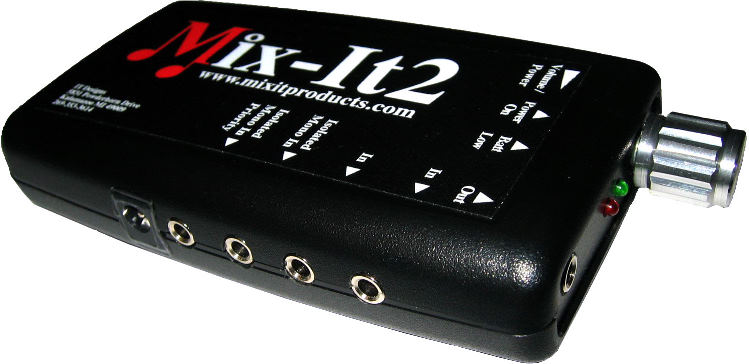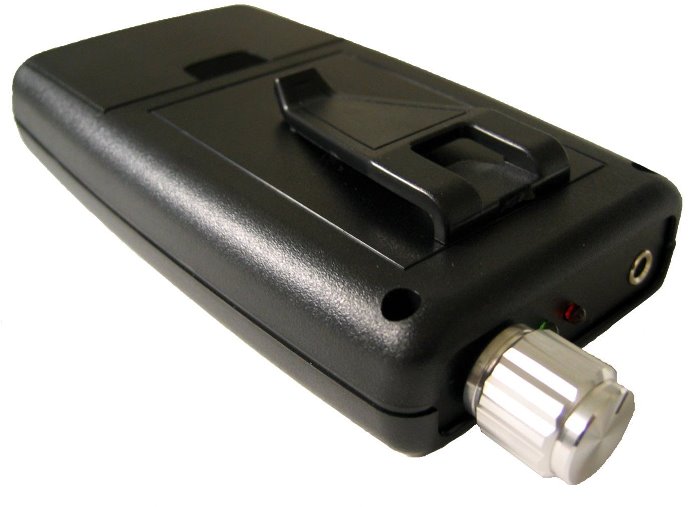The Original pocket size audio mixer and amplifier.
Hear it all: radar detector, talking GPS, MP3, CD, CB, Satellite radio... ANY four devices with a headphone jack, simultaneously!
- On/Off power control & master volume.
- Green power indicator
- Red low-battery indicator
- Stereo output jack connects to:Earphones
- Helmet speakers (motorcycle, snow mobile)
- Powered speakers
- AUX (line) input of Autocom, J&M CB,
car power amplifier, etc.
[*](2) stereo inputs (MP3 players, CD, FM radio, etc.)
[*]Mono isolated input (no need for special isolation
cables) for GPS, radar detectors, CB radio, etc.
Audio is presented in both ears.
[*]Priority mono input mutes all other inputs when a signal is present.
[*]12v noise filtered external power jack (power cord included)
- 9v battery compartment (battery included)
- Belt/tankbag clip
Additional specifications:
- Dimensions: 5.5"L x 2.75"W x 1"H
- New amplifier design provides 25dB gain (9x!), CD quality signal to noise ration (95+dB)
- Battery low indicator comes on with approximately 1 hour battery life remaining
- Filtered external power jack elimnates ignition noise.
- Dual powered (9v battery OR 12v external power)
- Battery life: 24 hours continuous use
- External power range of 11v-18v, no converter or step-down required.
- 0.25 amp power draw when on (surface draw of .2mA when powered off)
What does the Mix-It2 do?
The problem: Many motorcycle riders would like to listen to music from their MP3 players, CD player, AM/FM radio, etc. while still being able to hear a radar detector alert, GPS turn-by-turn directions, or CB radio. Until now, the only solution has been to listen to one device or the other (for instance, listening to music and counting on visual alerts from the radar detector which is not easily seen during daytime riding), or buying a cheap 'Y' cord from an electronics store to connect two devices together. The problem with the 'Y' cord approach is that some devices are not compatible with each other, and one device can damage another by using this type of cord. When you have invested so much money in your equipment, do you really want to take that risk? In addition to compatibility problems, some audio devices simply are not loud enough to be heard clearly while riding.
The solution: The Mix-It2! Of course! The Mix-It2 allows the user to plug in up to 4 devices simultaneously and keeps them electrically isolated so they cannot damage one another. It has been tested and is compatible with many devices: MP3 players, CD players, cassette players, AM/FM radios, satellite radio receivers, essentially ANY device with a headphone output! It also has a built-in amplifier and volume control to boost audio levels so they can be heard above road noise, which itself is a great benefit to the user. The output of the Mix-It2 can also be connected to the AUX input of other devices: car stereo systems, Autocom and J&M CB communications systems, nearly anything with a line-level input.
How it works: A common setup is a music player and radar detector. Set the volume control on the Mix-It2 between 1/4 to 1/2 way. Plug in and turn on your music player and set it to a comfortable volume level using it's volume control. Then turn on the radar detector and set it's volume to a level so you can hear it distinctly over the music. Since the radar detector only generates a tone when there is an alert, you will primarily only hear your music. This sets the "balance" of the device volume levels. The volume control on the Mix-It2 is then used to adjust the volume level heard of both devices with one convenient control. Why four inputs? You likely will not listen to four devices at once, but you can connect them all and then power on the ones you want to hear at any given time and power off the others. Connect your MP3 player, FM radio, radar and GPS and if you grow tired of the FM radio (or travel out of range of your favorite station) turn the FM radio off and MP3 player on - no need to mess with wires and volume levels - set them and forget them!
Note: The Mix-It2 does not provide a microphone interface or communications capability and will not work for conducting conversations on a cell phone or CB radio without additional hardware and/or cables.
































































